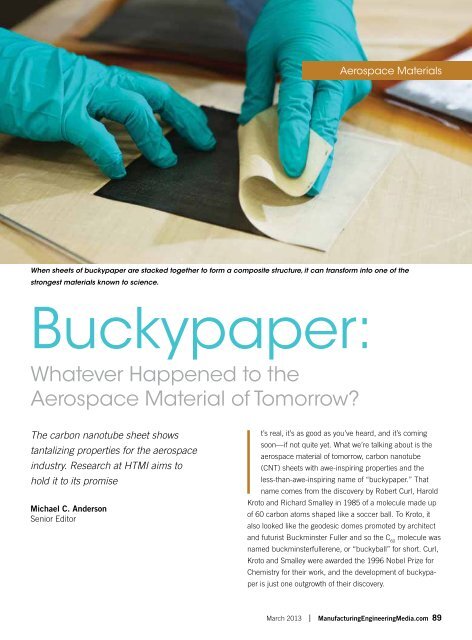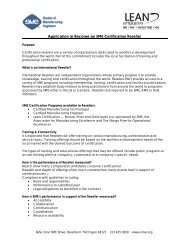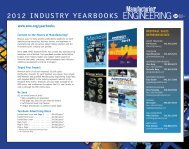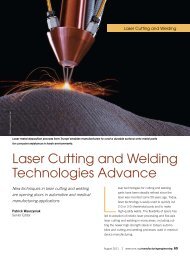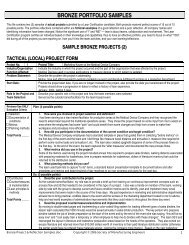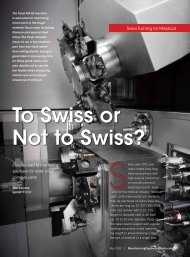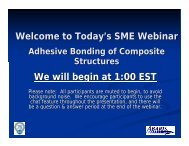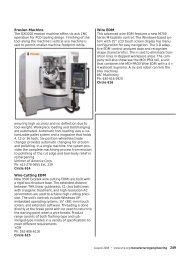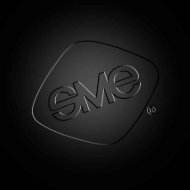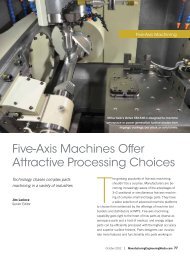Buckypaper: - Society of Manufacturing Engineers
Buckypaper: - Society of Manufacturing Engineers
Buckypaper: - Society of Manufacturing Engineers
- No tags were found...
Create successful ePaper yourself
Turn your PDF publications into a flip-book with our unique Google optimized e-Paper software.
Aerospace MaterialsWhen sheets <strong>of</strong> buckypaper are stacked together to form a composite structure, it can transform into one <strong>of</strong> thestrongest materials known to science.<strong>Buckypaper</strong>:Whatever Happened to theAerospace Material <strong>of</strong> Tomorrow?The carbon nanotube sheet showstantalizing properties for the aerospaceindustry. Research at HTMI aims tohold it to its promiseMichael C. AndersonSenior EditorIt’s real, it’s as good as you’ve heard, and it’s comingsoon—if not quite yet. What we’re talking about is theaerospace material <strong>of</strong> tomorrow, carbon nanotube(CNT) sheets with awe-inspiring properties and theless-than-awe-inspiring name <strong>of</strong> “buckypaper.” Thatname comes from the discovery by Robert Curl, HaroldKroto and Richard Smalley in 1985 <strong>of</strong> a molecule made up<strong>of</strong> 60 carbon atoms shaped like a soccer ball. To Kroto, italso looked like the geodesic domes promoted by architectand futurist Buckminster Fuller and so the C 60molecule wasnamed buckminsterfullerene, or “buckyball” for short. Curl,Kroto and Smalley were awarded the 1996 Nobel Prize forChemistry for their work, and the development <strong>of</strong> buckypaperis just one outgrowth <strong>of</strong> their discovery.March 2013 | <strong>Manufacturing</strong>EngineeringMedia.com 89
Aerospace MaterialsThis small-scale aircraft model demonstrates howbuckypaper allows lightning’s electrical chargeto flow around the plane and dissipate withoutcausing damage.Science-Fiction Features<strong>Buckypaper</strong> is about 25-µm thick and madefrom CNT fibers about 1/50,000th the diameter <strong>of</strong>a human hair. The nanotubes have atomic bondspowerful enough to make them twice as hard asdiamond. When sheets <strong>of</strong> buckypaper are stacked,the resulting composite material is 10 times lighterthan steel—but 250 times stronger. The implicationsfor aerostructures—increased payloads and improvedfuel efficiency—are tantalizing.Also, unlike conventional composite materials,buckypaper conducts electricity about as well assilicon and disperses heat like steel. Instead <strong>of</strong> the90 <strong>Manufacturing</strong>EngineeringMedia.com | March 2013
Aerospace Materialsmetal mesh currently used in the structure <strong>of</strong> the compositeaircraft to disperse lightning strikes, buckypaper, with itshigh current-carrying capacity, would allow lightning’s electricalcharge to flow around the plane and dissipate withoutcausing damage.Furthermore, buckypaper is flame retardant and could oneday help prevent fires on aircraft, ships and other structures.Its strength-to-weight ratio might also prove ideal when makingprotective gear, including helmets and body armor, for themilitary and police, as well as create improved, more comfortableprosthetics for wounded veterans. Such features explainwhy the US Air Force and companies including Raytheon andLockheed Martin have been investing in R&D efforts aimed atgetting the material to fulfill its promise.Florida State University’s High-Performance Materials Institute(HPMI; Tallahassee), where C 60co-discoverer and NobelLaureate Harold Kroto serves as senior science advisor—ispaving the way when it comes to narrowing the gap betweenresearch and the practical use <strong>of</strong> buckypaper. Nobel LaureateRichard Smalley first produced buckypaper during the1990s by filtering a nanotube suspension in order to preparesamples for various tests. HPMI has spent the past severalyears building upon this work, making buckypapers larger andmore multifunctional for composite fabrication and achievingseveral patents for its efforts.Composites Dominate inAero Materials ResearchWhile research on buckypaper continues, other materials also havethe aerospace industry’s attention. Titanium, aluminum and high-nickelalloys such as Inconel will continue to hold interest, but the lion’s share<strong>of</strong> aerospace materials-related R&D is being done with composites,according to George N. Bullen, president and CEO <strong>of</strong> Smart Blades Inc.(Oxnard, CA).“By far, the largest investment in change to materials, materialsbaselines, and materials processes has been in composite materials,”Bullen recently told ME. He noted four primary areas where the nextstage <strong>of</strong> incorporation can become cost effective to leverage the advantages<strong>of</strong> composite structures into large aero structures:Elimination <strong>of</strong> the autoclave for the cure <strong>of</strong> autoclave-cured materials.One method recently demonstrated successfully is In-A-Bag cureor degassing cure. If large composite structures can be cured usinghigh-strength autoclave cure materials, out <strong>of</strong> the autoclave, then thecost, complexity and limitations <strong>of</strong> installing and operating an autoclavewould be eliminated in the manufacturing process.Another approach is to bond large structures including substructuresinto a single unified piece <strong>of</strong> aero-substructure. If bondingtogether <strong>of</strong> large skins and a substructure can be achieved that result inthe same high-strength properties <strong>of</strong> a fastened aero-substructure, thensignificant cost and complexity would be reduced in the manufacturingprocess. There are currently major efforts to achieve this goal.If large unified structures can be achieved out <strong>of</strong> the autoclave,then methods and machines need to be and are being developed thatcan lay down large quantities <strong>of</strong> time-sensitive materials. When largestructures are manufactured using composites, tooling and materialhandling become challenges, which are being addressed, and will in thenear future migrate into the manufacturing process.InSitu inspection, test, and evaluation systems for large compositesstructures are under development. Small structures currently madeby hand are moved to the inspection areas for review after fabrication.As structures grow, they may be beyond the capability <strong>of</strong> factories tomove to inspection machines.92 <strong>Manufacturing</strong>EngineeringMedia.com | March 2013
Aerospace MaterialsReal-World ChallengesIt’s taking longer than they might have hoped: There wasa flurry <strong>of</strong> interest in buckypaper in 2008 and 2009—it wasnamed as one <strong>of</strong> SME’s “Innovations That Could Change theWay You Manufacture” in 2009—and media reports fromthat time made it sound like the material would be readyfor use in production imminently. However, right now HPMIis producing buckypaper at only a fraction <strong>of</strong> its potentialstrength, in small quantities and at a high price. <strong>Buckypaper</strong>may be the aerospace material <strong>of</strong> tomorrow, but tomorrow, toparaphrase Broadway’s “Annie,” is still a day away.As HPMI notes on its Web site (hpmi.net), “Nanotubereinforced composite materials have yet to demonstrate theirmuch-anticipated success due to non-uniform dispersion,lack <strong>of</strong> nanotube orientation, and weak interface betweennanotubes and the matrix.” The institute is currentlyresearching an innovative processing method to improvenanotube-reinforced polymer composites using buckypaper/resin infusion techniques. The goals <strong>of</strong> the project are to prepareand test nanotube reinforced composites using a highmagnetic field to realize nanotube alignment and establisha comprehensive database for producing and deployingbuckypaper/resin infusion composite materials.Inside HPMISituated inside a new $20 million, 45,000-ft 2 (4185-m 2 )building that houses 13 laboratories, HPMI brings togetherhighly technical researchers and state-<strong>of</strong>-the-art equipmentto continually explore and realize the astounding potential <strong>of</strong>NOLES, or nanotubes optimized for lightweight exceptionalstrength. Researchers go from idea to concept to prototypeand beyond, working one-on-one with private businessesand the government with complete confidentiality to meet thespecific needs <strong>of</strong> each partner.Both researchers and students have access to the facility’sequipment, which is valued at more than $10 million.94 <strong>Manufacturing</strong>EngineeringMedia.com | March 2013
Aerospace MaterialsThey can watch the tiniest particles come alive under ascanning electron microscope that has 100,000 times moremagnification than what is found in a high school laboratory.And strong composite materials that once seemed impossibleto cut, researchers and students are easily slicingaway thanks to a powerful abrasive waterjet machine. HPMIhas been successfully using an Omax 55100 JetMachiningCenter for the past six years to quickly and accurately cut awide variety <strong>of</strong> components, some lessthan a quarter <strong>of</strong> an inch in size.“We don’t always needthe more expensive singlewallnanotubes to get theproperties we want.”“The composite materials we workwith are really strong, and I can’t think<strong>of</strong> a material we haven’t cut on theOmax,” said Jerry Horne, an HPMIengineer who cuts materials for studentsand researchers. “It doesn’t matter howstrong the material is because the Omaxwill cut through anything.” The machineis designed to accommodate the cutting<strong>of</strong> large, complex parts and can handlesheet materials <strong>of</strong> up to 5 × 10' (1.524× 3.048 m) in dimension. Furthermore,its user-friendly controls simplify theprogramming <strong>of</strong> traditionally complextechniques. In fact, Horne can machinestudent components directly from aCAD drawing or DXF file.Getting CloserThe era <strong>of</strong> buckypaper use inproduction is getting closer, insist thescientists and engineers at HPMI. Accordingto Frank Allen, HPMI operationsdirector, the facility was producingbuckypaper at the size <strong>of</strong> a quarter backwhen he joined the institute in 2001,and now it is making much larger sheetsusing a batch production process.Eleven years ago, the price <strong>of</strong> thebest quality single-walled nanotubeswas approximately $500 a gram. Today,96 <strong>Manufacturing</strong>EngineeringMedia.com | March 2013
Aerospace MaterialsOmax 55100 JetMachining Center at the High-Performance Materials Institute is used to cut a wide variety <strong>of</strong>components, including carbon fiber composites.single-walled nanotubes are about $200 a gram and theprice continues to decline. Furthermore, multi-walled nanotubesare available for purchase by the pound and nan<strong>of</strong>ibersby the barrel. Allen noted that the facility tailors whichform <strong>of</strong> nanotubes it uses based on properties required forthe buckypaper.“We don’t always need the more expensive single-wallnanotubes to get the properties we want,” Allen said. “Thequality <strong>of</strong> the nanotubes we use makes a difference, and rightnow we are trying to make it cheaper by improving the manufacturingprocess <strong>of</strong> the buckypaper.”In an attempt to make buckypaper more commerciallyfeasible, the High-Performance Materials Institute is looking toscale up its production by working on a prototype that wouldproduce buckypaper strips at 5 fpm (1.5 m/min).While HPMI research on buckypaper is at the forefront<strong>of</strong> a technological revolution, it is still in its infancy stage.But despite the hurdles that come with trying to producebuckypaper for practical use, the researchers at FloridaState University are not about to give up. And why shouldthey? Even Thomas Edison’s improvement <strong>of</strong> the light bulbdid not happen overnight. He relied on existing research toinvent a total <strong>of</strong> seven system elements before the practicalapplication <strong>of</strong> electric light was possible. <strong>Buckypaper</strong>use in aerospace production will likewise eventually see thelight <strong>of</strong> day. ME98 <strong>Manufacturing</strong>EngineeringMedia.com | March 2013


